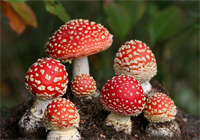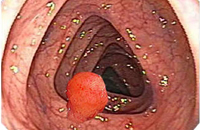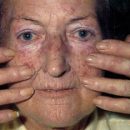Acute toxic gastroenteritis - poisoning to toxins contained in food products of vegetable and animal origin. Radiation (radiation) intestinal lesions are due to the impact on the organism of ionizing radiation.
Content
Acute toxic gastroenteritis — poisoning to toxins contained in food products of vegetable and animal origin.
Poisoning mushrooms
 Inedible mushrooms (pale toadstool, amanita, etc.) contain a muscarine substance. A few minutes after their use, tearing, salivation, sweating appear.
Inedible mushrooms (pale toadstool, amanita, etc.) contain a muscarine substance. A few minutes after their use, tearing, salivation, sweating appear.
Vomiting, diarrhea and gravating pain in the stomach are also characteristic, after some time the jaundice appears due to damage to the liver. The coma (complete or partial loss of consciousness) is then developing, convulsions are possible (sudden involuntary muscle contraction). Poisoning can end death after a few hours, with proper treatment, recovery occurs within 1 day. Mortality for poisoning exceeds 50%.
With any form of poisoning, you must urgently consult a doctor. At the same time, it is very important to render poisoning first help. First the patient must be put on the bed. If you have affected consciousness, you need to rinse him a stomach, a finger or a stalk of a spoon, pressing the root of the tongue, call him vomiting. Washing the stomach repeat 2-3 times (to pure washing waters - 10-12 liters of cool water fractionally 300-500 ml). With the development of convulsion, it is important to prevent a breakdown of breathing through the spasm of chewing muscles, so in the mouth of the victim you should insert a stalk of a spoon wrapped with a bandage or a nose handkerchief. Attach to the fear of the harrant during cramps or cooling legs.
You can give a patient to drink small sips Cold salted water - one teaspoon of cook salt on 1 cup of water. It is impossible to give patients with alcoholic beverages, as they contribute to the spread of poison in the body. Food remnants that patient consumed or vomits need to show a doctor for further research (before it comes to collect in the bank, close, put in the refrigerator).
Poisoning plants
Many wild and garden plants and shrubs (grained, some varieties of beans, nuts and chestnuts, etc.) contains toxic substances in leaves and fruits. Brussels cabbage leaves and tubers contain Solanin — Substance that may have people sensitive to him to cause nausea, vomiting, diarrhea and weakness. Bread cereals can affect the fungus containing ergotamine.
Fish poisoning and marine animals
Many fish inhabiting the Pacific Ocean and the pools of the waters near Florida, Western India, in the process of vital activity accumulate poisonous substances. Poisoning fish associated with toxins contained in it. Especially poisonous large old fish specimens. Symptoms of poisoning appear a few hours after meals. Characterized nausea, vomiting and diarrhea. Frequently appear skin itching, paresthesia (sensations of numbness, crawling goosebumps and tingling), headache, muscle pain, loss of temperature sensitivity. Some of these symptoms may continue for several months, making a person inoperable. When using rotten fish, it is possible to poison from histamine. Histamine is formed in large quantities in the process of bacterial decomposition; Causes a sharp redness of the face, nausea, vomiting, pain in the epigastric area and sprinkle on the skin. Symptoms appear a few minutes after meals and continue for several hours. In the summer months of the year of mussels, mollusks and oysters may contain a toxic substance - thermostable neurotoxin. Poisoning is manifested by paresthesia (sensations of numbness, crawling goosebumps and tingling) arising a few minutes after eating the specified mollusks. Then there are nausea, vomiting and grapple-shaped abdominal pain, muscle weakness ending with peripheral paralymps. Palsy is the lack of movement in the muscle or muscle group. Death can come due to respiratory stop.
Radiation (radiation) intestinal lesions
Radiation (radiation) intestinal lesions are due to the impact on the organism of ionizing radiation.
Cells of fine and large intestines are especially susceptible to acute radiation damage. Acute damage to the mucous membrane does not always cause clinical symptoms and after the completion of radiation therapy may end with its full restoration. In the rim and rectakes, inflammation and change in the mucous membrane, as a rule, lead to the development of acute colitis (inflammation of the mucous membrane of the thick bowel) and the proctitis (inflammation of the mucous membrane of the rectum). The manifestation of these diseases is very similar to those with ulcerative colitis (chronic inflammation of the colon with the development of ulcers, bleeding and dumping). Moreover, treatment with anti-inflammatory accumulation hormones (corticosteroids) and sulfasalazine has a good effect, especially when using them in the form of enema.
More massive irradiation causes inflammation of the mucous membrane of the small intestine (enteritis) and colitis (inflammation of the fat intestine mucous membrane) weeks and even years after radiation therapy has been completed.
Manifestation of radiant intestinal lesion
The radiation lesion of the intestine develops most often in patients with oncological diseases receiving radiation therapy with a tumor of a small pelvic or lymph nodes. More sensitive to ionizing radiation The mucous membrane of the small intestine (radiation enteritis), the mucous membrane of the colon is less sensitive. Damaging effect is characterized by inflammation. For radiation enteritis, the development of impaired suction syndrome is more characteristic. The impaired suction syndrome is manifested by the loss of body weight in the conditions of full nutrition, dryness and peeling of the skin, the change in its color: a kind of dirty gray shade, pigment spots on the face and neck, a darkening of the skin of the face, neck, brushes, legs and stop. In the corners of the mouth, mobbing cracks may appear behind the ears or in the wings of the nose. Nails become dull, smell. The hair falls out, thin, sometimes at the ends. Changes language. It can be loose, pale, edema, with fingerprints of teeth around the edges. In other cases, it becomes raspberry-red. Sometimes the language becomes completely smooth, as if polished. An increased bleeding of gums, point or subcutaneous hemorrhages may be observed. Evenkers appear in the field of the heads and stop.
Heavy radiation lesions of the intestines are possible only with acute radiation disease caused by either powerful external irradiation, or massive internal irradiation in the gastrointestinal tract. In these cases, severe diarrhea is developing.
The diagnosis of radiation lesion of the intestine is based on identifying the fact of radiation impact. Instrumental methods allow you to identify changes in the intestinal mucosa.









